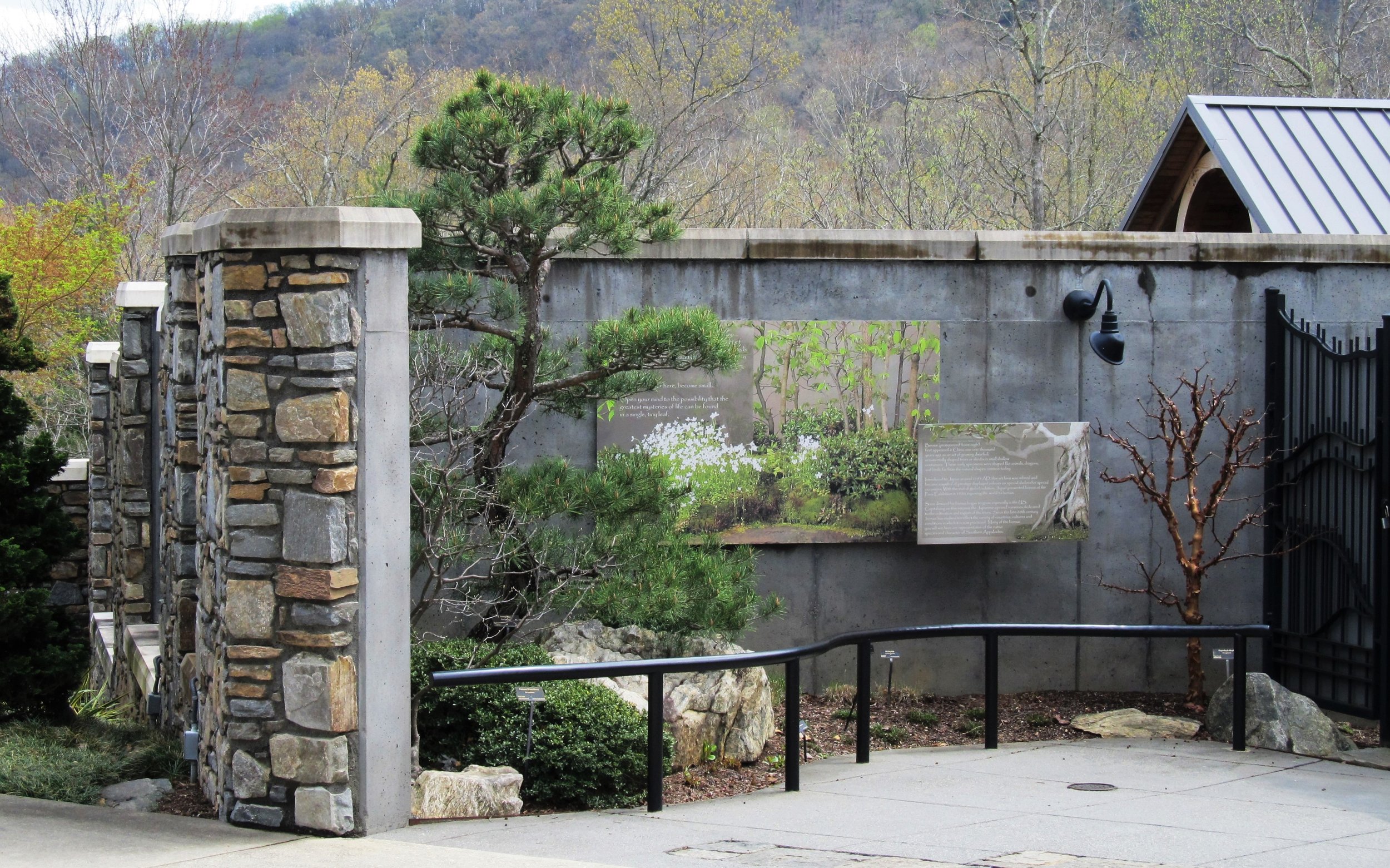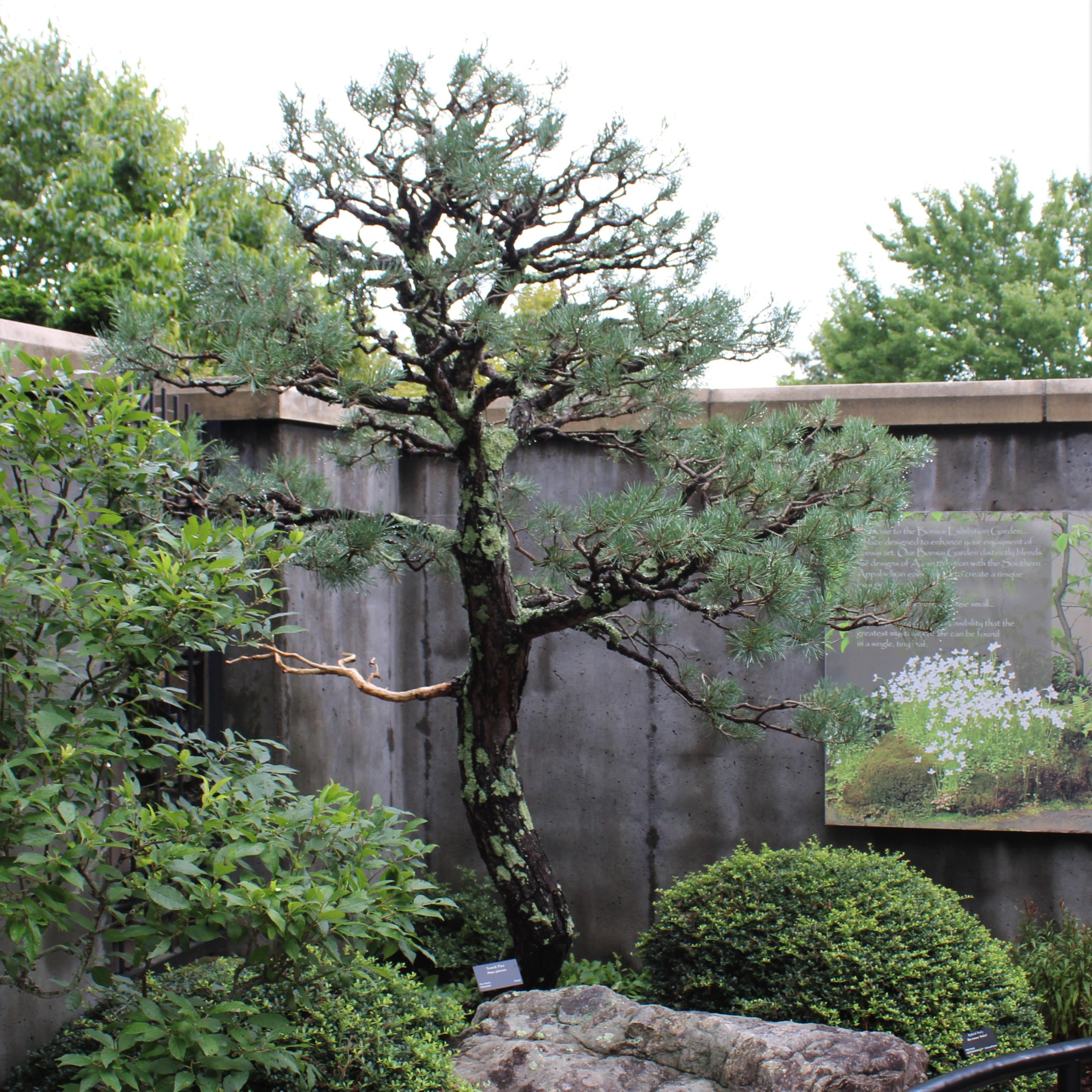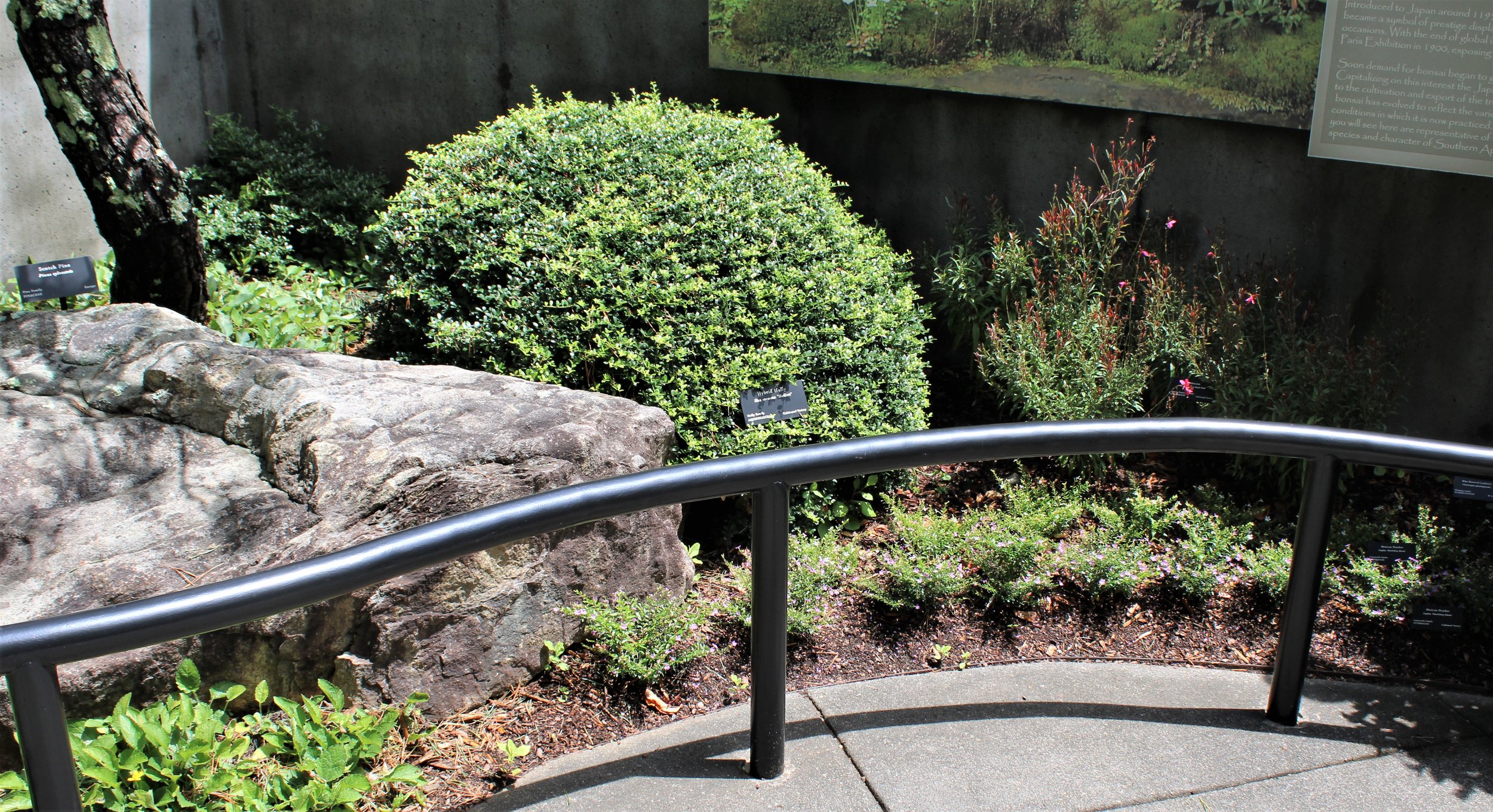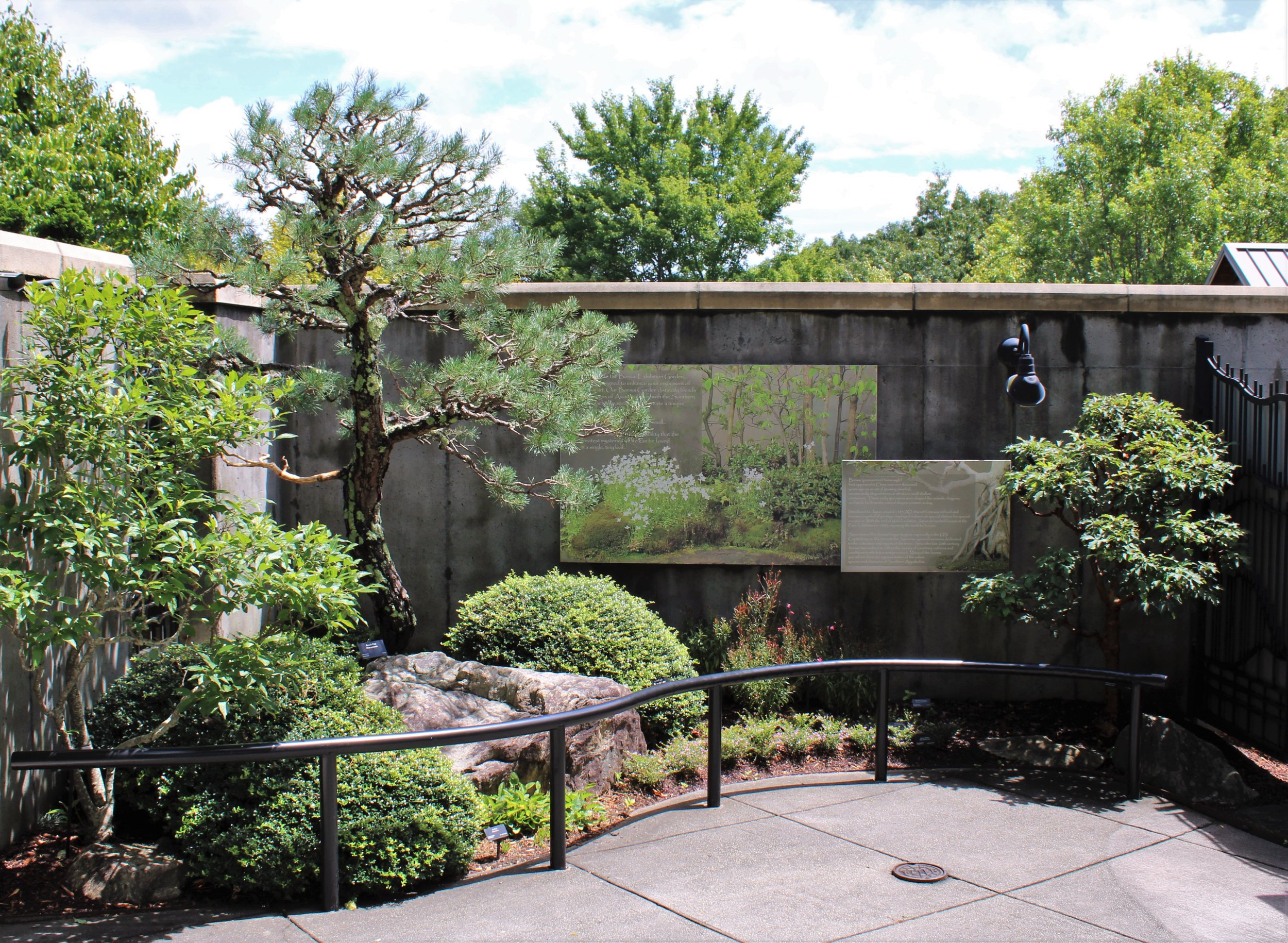Upper Level Entry Garden
It was time to prune the pine. Actually, it was past time to prune the pine, but the pine always gets pruned sometime after it should. The tree in question is a Scots pine (Pinus sylvestris), located in a small garden that sits just outside the upper entrance to the bonsai garden. The purpose of this planted space is to welcome guests to the bonsai garden, and in accordance with that there is also informational signage contained within the space. Other plants in this location include a paperbark maple (Acer griseum), a native winterberry holly (Ilex verticillata), a few hybrid evergreen hollies (Ilex crenata 'Helleri') and some herbaceous plants that are changed out from time to time. The centerpiece of the arrangement, however, is the Scots pine.
This small area is referred to as the Upper Level Entry Garden. It is very much part of the bonsai garden and it is maintained in the same manner. That means the Scots pine is pruned and shaped in a way that gives it an appearance suggestive of a bonsai. It cannot rightly be called a bonsai because its roots are in the ground, but it's kept small through pruning and given a particular appearance, the same as is done with a bonsai. The most common association for these sculpted trees is with Japanese gardens. When trees are pruned this way for use in Japanese gardens they are called niwaki. Here is a picture of a niwaki from the Japanese garden at the Chicago Botanic Garden:
That sculpted pine tree is but one of an impressive number of niwaki in a large, sprawling area otherwise covered in turfgrass:
How accurately this garden reflects the Japanese aesthetic is debatable, but the many neatly-grown trees with their unusual shapes certainly give the space a magical feeling.
The Scots pine in our upper level entry garden is not a niwaki. It does not intend to be one and does not have the look of one, and if it did look like one it would be out of place in the Bonsai Exhibition Garden, which is not intended to be a Japanese garden. Instead, our Scots pine is shaped to look convincing as a natural tree kept to miniature dimensions, similar to pines you might find in the higher elevations around here:
As it happens, many of the niwaki at the Chicago Botanic Garden are also Scots pines, proof that Pinus sylvestris is capable of being grown for that Japanese garden look. There is a cultivation technique used to produce pine trees with those distinctive cloud-like foliage masses, and the technique is known as candling. When pine trees grow in the springtime, the new shoots emerging from the branch tips are called candles. At a certain point in their development, after elongation but before any needles appear, the candles are pruned to make them shorter. This limits the amount of new foliage acquired and thereby keeps the the overall growth of the tree more compact. Candle pruning also stimulates greater bud development for next year's growth, and this leads to denser foliage masses. The timing of this pruning technique is rather specific. The very time when the candles on our Scots pine ought to be addressed is when so many other springtime chores want doing, and there isn't time to do everything. Once the window of candle pruning opportunity closes that technique is off the table, and you either wait for next year to try again, or you use a different pruning approach that is not so time sensitive. There are, of course, other ways to go about sculpting a garden pine tree.
The Upper Level Entry Garden has been a fairly consistent component of the bonsai garden. The larger elements of the space — the pine, the maple, the hollies and the signage — were all originally installed in 2005 shortly before the garden opened to the public. The planting scheme was developed by Mike Oshita, a certified Japanese garden designer who was part of the team assembled to work on the bonsai garden design. Although the bonsai garden was never meant to be Japanese in its identity, some essence of the Japanese garden aesthetic was conceived to be desirable, and Mike brought that to the table in an authentic way.
Originally, a native tree species was intended to be the focal point of the planting. A table mountain pine (Pinus pungens) that had previously been planted out in front of the Production Greenhouse was dug up, then balled and burlapped and put in a holding area in preparation for being transplanted. But that tree did not like being dislocated and began looking poorly soon afterwards. By the time it became obvious that the table mountain pine was failing and would not be usable, it was only a few weeks until the bonsai garden was scheduled to be opened to the public. A replacement needed to be found as soon as possible. The Arboretum asked Mike if he knew where we could find another suitable specimen, and he explained that such trees are a specialty item not readily available anywhere nearby. We then asked if he had any of his own that might be available. Mike reluctantly acknowledged that he did have one, but he was saving it for his own use. We pressed him on the matter, citing the prominence of this project and the last-minute nature of our need. He hemmed and hawed then finally gave us a price and we paid it. The tree Mike sold us was a good young specimen, a field-grown Scots pine ten years in development at the time of installation.
The following images show the planting of that tree in late summer of 2005. Mike Oshita is the man with dark hair and glasses, wearing khaki pants and an orange shirt (click on any image for full view):
The first available image of the entirely assembled Upper Level Entry Garden planting comes from approximately a year later, in the autumn of 2006:
A year later, in autumn of 2007, the garden plantings all look good, with ample growth indicating they had established well:
One replacement had been made — the small shrub located to the right of the Scots pine and under the smaller of the two signs was changed out. In the original design that space had been filled by a dwarf hinoki falsecypress (Chamaecyparis obtusa 'Nana gracilis'), but in this image we see that plant had been replaced with a cultivated form of Atlantic whitecedar (Chamaecyparis thyoides cv.). An herbaceous layer had been added, too. Unfortunately the plant selected for that use was marginal shield fern (Dryopteris marginalis), which, despite assurances from the seller that the plant would tolerate full sun, was miserable in the exposed location.
This 2009 image shows the effects of a late snow in early spring:
Later that same year the bright red fruit of the deciduous holly highlights a pretty winter tableau:
This photograph from the summer of 2011 captures the Upper Level Entry Garden looking lush and fulsome:
By the time of the above image, the marginal shield fern had been replaced by a prairie grass called sideoats grama (Bouteloua curtipendula). The grass was a better choice for the conditions of the site, but quickly proved too robust for where it was situated. The whitecedar was also prospering, and soon began to interfere with the visibility of the sign above it.
In 2012 I decided to do some significant branch removal on the Scots pine. The tree originally had numerous instances of primary branching in opposite pairs, a formation that can create a rigid compositional feeling. As the tree’s crown filled out and began to get crowded, it became convenient to reduce density by selectively removing one or the other of opposing branches. That same year further adjustments were made in the herbaceous underplanting. Some of the sideoats were retained but relocated to the rear, planted at the base of the wall under the larger sign. The whitecedar was removed altogether. The foreground planting now consisted of leadwort (Plumbago auriculata) in front of the large rock, and a pink flowering tickseed (Coreopsis rosea 'American Dream') in front of the sideoats:
The following image shows the Upper Level Entry Garden in very early spring in 2013. Note that the sideoats and tickseed are both cut down to the ground in winter and come back in spring as tight masses of spiky shoots:
A rainy day in late autumn 2015 creates a colorful but somber scene:
I had for several years been concerned about the lower branches of the Scots pine. Although adjustments had been made to compensate for the discrepancy, the upper portions of the tree grew with much greater strength than did the lower limbs. Those lower limbs were floppy, drooping to the point of laying on the rock in front of the pine, and the foliage they carried was loose and leggy. This view of the tree illustrates the effect:
I had taken to thinking of these lower limbs as skirts. I thought the pine's skirts needed to be raised. Making such a move would produce a very noticeable change in the tree's appearance, however, and once removed those branches couldn't be restored. After thinking on the matter and visualizing the outcome, in 2016 I made the decision to cut off the lower limbs and send the Scots pine down an alternative path toward a different personality:
This scene from a beautiful autumn day in 2020 shows the developing character of the pine in its new form:
With the lower limbs removed, it is possible to better appreciate the trunk and branch structure of the tree, as seen in this image from 2022:
That leads us to the present year, when just earlier this week I realized it was time to prune the pine. Actually, it was past time to prune the pine because it looked like this:
The job was done after about seven hours of work over the span of two days. The Scots pine now has the trim, open, comparatively austere look it typically has after its annual pruning session:
The gallery below features three different pairings of before and after images, illustrating the effects of the pruning work (click on any image for larger view):
One dramatic alteration accomplished this year was the reduction of a branch that had run out of room to grow. The Scots pine is situated in a corner, with walls on two sides. The lowest branch on the left side of the tree had grown to the point where it was physically in contact with the walls and had become weak and misshapen as a result of its disadvantaged position. As the years have gone by the Scots pine has become bigger, albeit slowly, while the confines of the space it occupies have remained the same. Something has to give, but still, I was concerned that taking off the branch entirely would leave too large a void. The solution was to leave the remnants of the branch in place as a deadwood feature, so the mass of foliage is gone but something of visual interest remains:
Meanwhile, down at ground level the composition of the herbaceous layer has changed once again:
The previous selection of herbaceous plants for this area had pretty well played out. The tickseed had vanished a few years after planting, while the leadwort and sideoats mixed up their arrangement and went where they pleased. The old plants were removed and replaced by beeblossom (Gaura ‘Belleza Dark Pink’) and two different varieties of Mexican heather (Cuphea ‘FloriGlory Maria’ and ‘FloriGlory Selena’). The beeblossom is perennial, so it will be back next year. The Mexican heather is an annual in this part of the world, so something else will likely take its place next year. The new plantings were designed and installed by the bonsai assistant in late spring.
The following gallery shows how the Upper Level Entry Garden and the Scots pine have evolved over the last seventeen years (click on any image for full view):


































